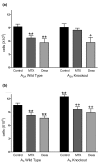Suppression of inflammation by low-dose methotrexate is mediated by adenosine A2A receptor but not A3 receptor activation in thioglycollate-induced peritonitis
- PMID: 16519795
- PMCID: PMC1526598
- DOI: 10.1186/ar1914
Suppression of inflammation by low-dose methotrexate is mediated by adenosine A2A receptor but not A3 receptor activation in thioglycollate-induced peritonitis
Abstract
Prior studies demonstrate that adenosine, acting at one or more of its receptors, mediates the anti-inflammatory effects of methotrexate in animal models of both acute and chronic inflammation. Both adenosine A2A and A3 receptors contribute to the anti-inflammatory effects of methotrexate treatment in the air pouch model of inflammation, and the regulation of inflammation by these two receptors differs at the cellular level. Because different factors may regulate inflammation at different sites we examined the effect of low-dose weekly methotrexate treatment (0.75 mg/kg/week) in a model of acute peritoneal inflammation in adenosine A2A receptor knockout mice and A3 receptor knockout mice and their wild-type littermates. Following intraperitoneal injection of thioglycollate there was no significant difference in the number or type of leukocytes, tumor necrosis factor alpha (TNF-alpha) and IL-10 levels that accumulated in the thioglycollate-induced peritoneal exudates in adenosine A2A knockout mice or wild-type control mice. In contrast, there were more leukocytes, TNF-alpha and IL-10 in the exudates of the adenosine A3 receptor-deficient mice. Low-dose, weekly methotrexate treatment increased the adenosine concentration in the peritoneal exudates of all mice studied, and reduced the leukocyte accumulation in the wild-type mice and A3 receptor knockout mice but not in the A2A receptor knockout mice. Methotrexate reduced exudate levels of TNF-alpha in the wild-type mice and A3 receptor knockout mice but not the A2A receptor knockout mice. More strikingly, IL-10, a critical regulator of peritoneal inflammation, was increased in the methotrexate-treated wild-type mice and A3 knockout mice but decreased in the A2A knockout mice. Dexamethasone, an agent that suppresses inflammation by a different mechanism, was similarly effective in wild-type mice, A2A mice and A3 knockout mice. These findings provide further evidence that adenosine is a potent regulator of inflammation that mediates the anti-inflammatory effects of methotrexate. Moreover, these data provide strong evidence that the anti-inflammatory effects of methotrexate and adenosine are mediated by different receptors in different inflammatory loci, an observation that may explain why inflammatory diseases of some organs but not of other organs respond to methotrexate therapy.
Figures

Similar articles
-
Adenosine A2A or A3 receptors are required for inhibition of inflammation by methotrexate and its analog MX-68.Arthritis Rheum. 2003 Jan;48(1):240-7. doi: 10.1002/art.10712. Arthritis Rheum. 2003. PMID: 12528125
-
Adenosine inhibits tumor necrosis factor-alpha release from mouse peritoneal macrophages via A2A and A2B but not the A3 adenosine receptor.J Pharmacol Exp Ther. 2006 Apr;317(1):172-80. doi: 10.1124/jpet.105.096016. Epub 2005 Dec 9. J Pharmacol Exp Ther. 2006. PMID: 16339914
-
Genetically based resistance to the antiinflammatory effects of methotrexate in the air-pouch model of acute inflammation.Arthritis Rheum. 2005 Aug;52(8):2567-75. doi: 10.1002/art.21208. Arthritis Rheum. 2005. PMID: 16059892 Free PMC article.
-
Perspective and Potential of A2A and A3 Adenosine Receptors as Therapeutic Targets for the Treatment of Rheumatoid Arthritis.Curr Pharm Des. 2019;25(26):2859-2874. doi: 10.2174/1381612825666190710111658. Curr Pharm Des. 2019. PMID: 31291875 Review.
-
Adenosine-dopamine interactions revealed in knockout mice.J Mol Neurosci. 2005;26(2-3):239-44. doi: 10.1385/JMN:26:2-3:239. J Mol Neurosci. 2005. PMID: 16012197 Review.
Cited by
-
The advances of methotrexate resistance in rheumatoid arthritis.Inflammopharmacology. 2020 Oct;28(5):1183-1193. doi: 10.1007/s10787-020-00741-3. Epub 2020 Aug 5. Inflammopharmacology. 2020. PMID: 32757110 Review.
-
The actions of methotrexate on endothelial cells are dependent on the shear stress-induced regulation of one carbon metabolism.Front Immunol. 2023 Jun 30;14:1209490. doi: 10.3389/fimmu.2023.1209490. eCollection 2023. Front Immunol. 2023. PMID: 37457690 Free PMC article.
-
Pharmacomicrobiology of Methotrexate in Rheumatoid Arthritis: Gut Microbiome as Predictor of Therapeutic Response.Front Immunol. 2021 Dec 16;12:789334. doi: 10.3389/fimmu.2021.789334. eCollection 2021. Front Immunol. 2021. PMID: 34975886 Free PMC article. Review.
-
Adenosine A₂A receptor agonist-mediated increase in donor-derived regulatory T cells suppresses development of graft-versus-host disease.J Immunol. 2013 Jan 1;190(1):458-68. doi: 10.4049/jimmunol.1201325. Epub 2012 Dec 7. J Immunol. 2013. PMID: 23225892 Free PMC article.
-
Medical Ozone Increases Methotrexate Effects in Rheumatoid Arthritis Through a Shared New Mechanism Which Involves Adenosine.Int J Mol Sci. 2025 May 29;26(11):5256. doi: 10.3390/ijms26115256. Int J Mol Sci. 2025. PMID: 40508064 Free PMC article. Review.
References
Publication types
MeSH terms
Substances
Grants and funding
LinkOut - more resources
Full Text Sources
Other Literature Sources

